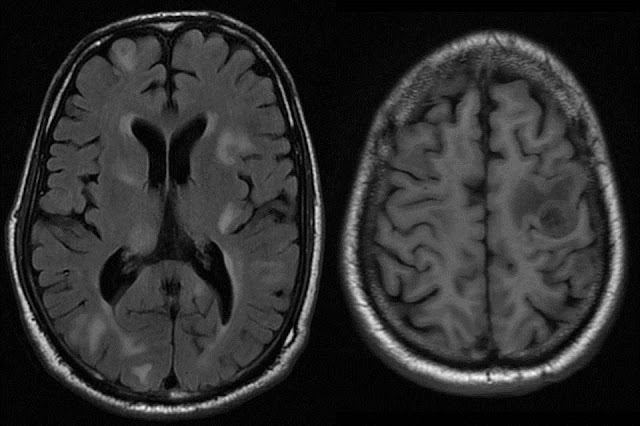 |
| Axial T2 FLAIR and T1 Wt images show multiple thick walled isointense lesions with central necrosis and surrounding edema, predominantly distributed at the corticomedullary junction. |
·
Primary and metastatic tumors, on imaging, often manifest as
rounded, well-circumscribed, ring-enhancing lesions of variable sizes
surrounded by a variable amount of perifocal vasogenic edema.
·
Metastatic tumors are the most common intracranial neoplasm in
adults.
·
Lung cancer, breast cancer and melanoma account for the majority
of patients with metastasis in the brain.
·
The incidence of brain metastases has recently increased because
of several factors, including improved survival, better treatment of systemic
diseases and improved intracranial imaging techniques.
·
There were no characteristic computed tomography patterns for
specific systemic carcinomas, but epidermoid carcinoma frequently appeared as a
low-density lesion with a thin peripheral enhancing rim, and adenocarcinoma
appeared as a dense, homogeneous, round, enhancing nodule.
·
After treatment, focal cerebral parenchymal enhancement was the
most reliable sign of residual or recurrent tumor.
·
Metastatic lesions are typically subcortical, occurring in or near
the gray matter-white matter junction, and are usually associated with severe
perilesional edema.
·
MRI typically reveals mild T1 hypointensity with T2 hyperintensity
and fluid-attenuated inversion recovery hyperintensity at the site of the
lesion.
·
After contrast administration, a nodular ring pattern of
enhancement is seen.
·
Metastases from malignant melanoma may demonstrate T1
hyperintensity because of hemorrhagic or melanin components of the lesion.
·
Rapidly growing primary brain tumors, such as glioblastoma
multiforme or anaplastic astrocytoma, can present with many of the same imaging
characteristics as seen in metastatic lesions of the brain.
·
Most of the primary tumors are large in size and are often located
deep in the white matter.
·
Primary brain tumors frequently cross the midline. For example,
glioblastoma multiforme frequently crosses the midline by infiltrating the
white matter tracts of the corpus callosum.
·
Differential diagnosis of multiple ring enhancing lesions of
brain:
Reference :
Garg RK, Sinha MK. Multiple ring-enhancing
lesions of the brain. J Postgrad Med 2010;56:307-16
view similar cases:http://radfacts.blogspot.in/2012/06/neurocysticercosis.html



No comments:
Post a Comment
Please leave your comments